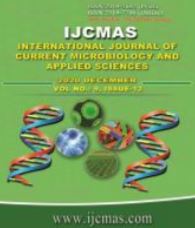


 National Academy of Agricultural Sciences (NAAS)
National Academy of Agricultural Sciences (NAAS)

|
PRINT ISSN : 2319-7692
Online ISSN : 2319-7706 Issues : 12 per year Publisher : Excellent Publishers Email : editorijcmas@gmail.com / submit@ijcmas.com Editor-in-chief: Dr.M.Prakash Index Copernicus ICV 2018: 95.39 NAAS RATING 2020: 5.38 |
Millets due to its difficult processing were left behind cereal grains like rice and wheat. But increasing number of life style disorders has again made the human race to realise the importance of millets in maintaining wellbeing. Objectives: To compare the nutritional value of barnyard millet and rice varieties and sensory quality and glycemic index of their products. Materials and Methods: Two varieties of barnyard millet (PRJ-1 and local cultivar) and two varieties of rice, Swarna (MTU-7029) and Mahsuri (BPT-5204) were procured. Proximate composition was analysed using AOAC (1995) procedure. Estimation of dietary fibre, resistant starch, tannic acid and antioxidant activity of barnyard millet was determined using the method given by Asp and Johanson (1981), McCleary et al., (2002), AOAC (1970) and Zhang and Hamauzu (2004) respectively. Sensory quality and glycemic index evaluation of products was done using 9 point Hedonic scale and score card method given by Amerine et al., (1965) and Wolever (1990) respectively. Results and Conclusion: The nutrition value of barnyard millet is significantly higher than rice varieties except for carbohydrate total physiological value. The sensory quality of food products (jeera jhangora, jeera rice, barnyard millet khichdi and Rice khichdi) shows non-significant difference. The Glycemic index of barnyard millet products (jeera jhangora) was significantly low then rice products (jeera rice) ranging from 35.9 (PRJ-1) - 39.5 (local cultivar) and 64.9 (Swarna)-73.9 (Mahsuri).The glycemic index of barnyard millet khichdi and Rice khichdi also show significant difference i.e. 34.96 (PRJ-1) and 62.50 (Swarna) respectively. The study thus concludes that barnyard millet products can be better utilized for their high nutritive value, low glycemic index value in life style diseases like diabetes as compared to rice. Recommendation: Barnyard millet can be a best substitute of rice for people suffering from diabetes owing to its low glycemic index, high nutritional value and similar (as rice) sensory characteristics.
 |
 |
 |
 |
 |